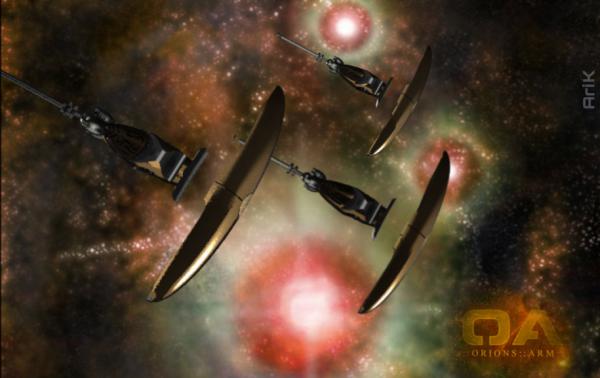BY LETTER
Xenosophont Civilisations in the Laniakea Supercluster
Sophonts > Xenosophonts > Alien Civilisations Outside the Terragen Sphere
Sophonts > Xenosophonts > Meistersingers
Sophonts > Xenosophonts > Muuh
Sophonts > Xenosophonts > Pas'utu'ril
Sophonts > Xenosophonts
Sophonts > Xenosophonts > Meistersingers
Sophonts > Xenosophonts > Muuh
Sophonts > Xenosophonts > Pas'utu'ril
Sophonts > Xenosophonts
Notable alien civilisations in the local galactic supercluster | |
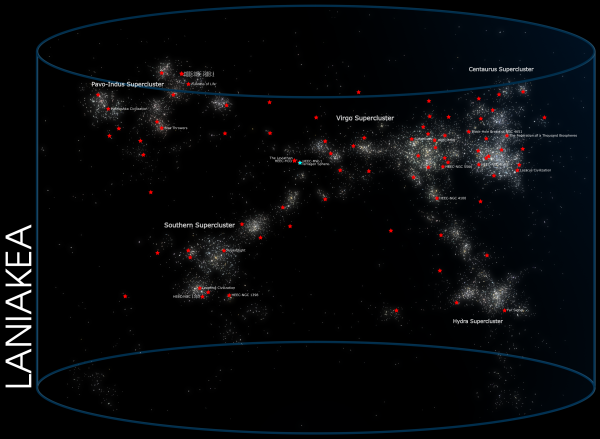 Image from MiyuwiAuthor adapted from Wikimedia Commons Image | |
| The Laniakea volume, 520 million light years across, holds a very large number of active xenosophont civilisations which have been detected at long distance by the Terragen Argus Array and related sensors | |
The Laniakea Supercluster consists of about 10,000 large galaxies, in addition to many more dwarf galaxies. It is itself made up of four smaller superclusters, named the Virgo, Hydra-Centaurus, Pavo-Indus, and Southern Superclusters, each of which is itself made up of many galactic groups and clusters. One of these, in the Virgo Supercluster, is the Local Group, containing the Milky Way and Andromedagalaxies, and over 50 dwarf galaxies including the Triangulum and LMC galaxies.
Laniakea is defined by its gravitational influence, and is about 520 million light-years across, though the Milky Way (and hence the Terragen Sphere) is not near the center. Clusters of galaxies such as the Local Group will be attracted to each other and form larger galaxies, for instance when the Milky Way and Andromeda collide and eventually merge, billions of years in the future. However, due to the accelerating expansion of the universe due to dark energy the Laniakea supercluster will eventually be ripped apart (unless the amount of dark energy in the universe changes unexpectedly for some reason, or intelligent life intervenes to change conditions deliberately).
Civilization Classification
Civilizations are classified into four energy emission classes, based on what technosignatures are observable.- High Energy Emission Civilisations (HEECs) are the rarest class, and occur in relatively few galaxies; the Terragen Sphere is one of these.
- Medium Energy Emission Civilisations (MEECs) are more common, and many larger galaxies contain several examples, although smaller galaxies may have few or none.
- Low Energy Emission Civilisations (LEECs) are even more common, but since they emit only limited emissions or display very minor changes to their environment, they are much more difficult to detect. Some galaxies, especially elliptical galaxies, have few or no detectable civilisations of any kind.
- Null Energy Emission Civilisations (NEECs) are almost impossible to detect from a great distance, and are generally indistinguishable from a life-bearing world without a civilisation. Within the Terragen Sphere a number of such worlds have been discovered by direct exploration, but at greater distances these are almost all a matter of conjecture.
Table of Contents
Local Group- HEECs
- Notable MEECs
- Notable LEECs
- Unclear Classification
Virgo Supercluster (Outside the Local Group)
- Notable HEECs
- Other Notable Civilizations
Pavo-Indus Supercluster
- Notable HEECs
- Other Notable Civilizations
Hydra-Centaurus Supercluster
- Notable HEECs
Southern Supercluster
- Notable HEECs
- Other Notable Civilizations
Related Multigalactic Phenomena
Though almost all civilizations are at least somewhat unique in their own way, the following are some of the most notable and famous xenosophont civilizations in Laniakea.
Local Group
The Local Group is home to 2 major galaxies and over 50 dwarf galaxies hosting a total of 4 HEECs, 36 MEECs, and 160 LEECs.Image from The Astronomer, MiyuwiAuthor, adapted from an ESA image | |
| The Milky Way Galaxy, home to the Terragens and a number of other civilisations | |
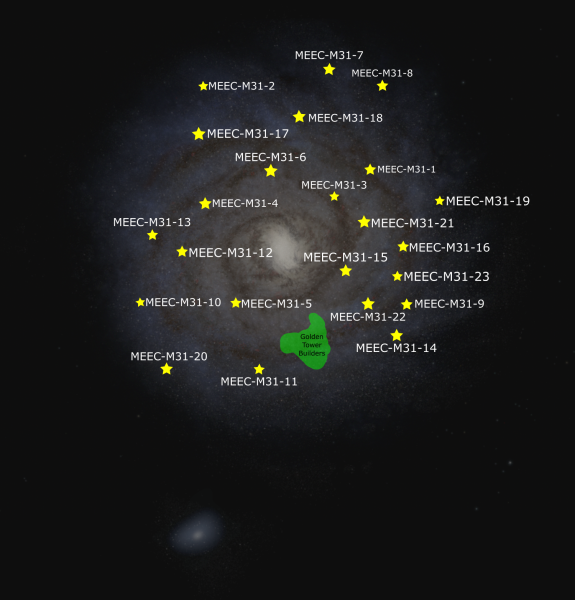 Image from MiyuwiAuthor, derived from an image by Steve Bowers | |
| The Andromeda Galaxy, home to the Golden Tower Builders and other civilisations | |
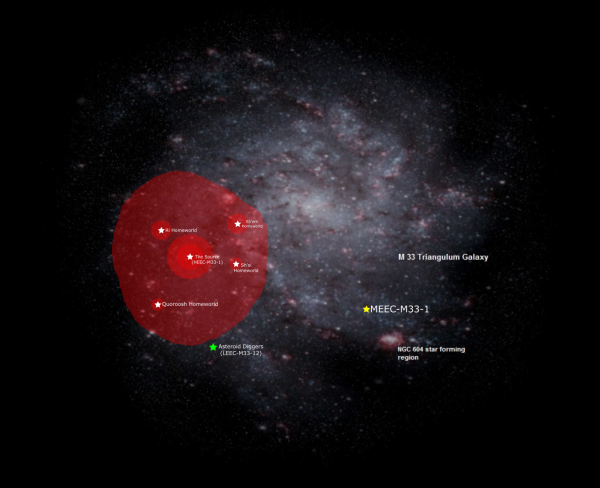 Image from MiyuwiAuthor and Steve Bowers | |
| The Triangulum galaxy, location of the HEEC known as The Source, and a number of other civilisations | |
HEECs
- Terragen Sphere (HEEC-MW-2): Our own civilization. The Terragen Sphere has been steadily and rapidly expanding for the last 10,000 years, growing from a single star system to incorporate approximately one billion stars as of the Current Era. It displays all the hallmark features of a rapidly expanding civilization including roughly cone-shaped volumes of space radiating outward from the center with distinct development patterns, though boundaries are fuzzy and enclaves are common, and concentrations of intense development in the core volume, which encompasses the Inner Sphere and, to a lesser extent, the Middle Regions. The Terragen Sphere possesses an extensive network of wormholes known as the Wormhole Nexus, which connects millions of star systems. In addition, it has also discovered two long-range wormholes, remnants of an ancient xenosophont wormhole network, which have caused it to extend further in certain directions than others. The controlling entities of the Terragen Sphere are the 34 S6 archailects, who are divided into numerous factions with varying levels of cooperation, some of which are more friendly to lower beings than others. Volumes of space controlled by these entities are known as empires, many of which have one or more defining characteristics, such as greater density of megastructures, matrioshka hypernodes, or artificial biospheres. Many more minor polities led by lesser beings exist alongside these empires. The population of the Terragen Sphere is diverse. Beings of all known toposophic levels can be found, from the greatest archailects to the numerous modosophont populations, which include virtual beings (who make up 99.8% of the total population), vecs, humans, provolves, neogens, and the several xenosophont species that have been encountered thus far.
- HEEC-MW-1: HEEC-MW-1 surrounds the galactic core. This civilization does not seem to inhabit any planets or other naturally occurring bodies, instead living entirely in orbital habitats and computronium banks, some of which are heavily shielded due to proximity to energetic core phenomena. This has led to speculation that at least some of this civilization consists of biological beings. HEEC-MW-1 has not changed in size in all the time it has been observed, but occasional construction of new habitats and computronium does still occur. Design similarities between ships observed in HEEC-MW-1 and those of the Meistersingers has caused some to suggest that this is in fact their home civilization, or at least that they had extensive friendly contact in the past. In addition, several other HEECs across Laniakea similarly occupy the core regions of their galaxies, leading to occasional speculation of some sort of connection between them, but most researchers consider this to instead be convergent cultural evolution.
- The Source (HEEC-M33): Thanks to the Triangulum Transmission, a great deal is known about this civilization. It is about 15,000 years old, and is ruled by a single S6 archailect known as The Source. Gengineering and AI technologies are in widespread use. There are a variety of higher toposophic beings, but only the Source has breached the Sixth Singularity. The Source originally developed from a hive mind made up of a species with a strong herding instinct. As it expanded into the galaxy, the Source discovered 4 more sophont species, which, under the Source's guidance, have become the core modosophonts of this society.
- The Leviathan: Made known to us thanks to the Triangulum Transmission, the Leviathan is by far the largest known civilization in Laniakea. It is a mobile artificial construct 10 light years across and massing as much as 100 billion Sol-like stars, moving toward the Local Group. Despite its enormity, nothing at all is known about its culture or motives.
Notable MEECs
- MEEC-MW-1: Located about 12,700 light years from Sol, and 7,200 light years from the edge of the current Terragen Sphere, this civilization was the first MEEC discovered in the Milky Way. It was first observed in 340 AT, although it was not fully confirmed as being of xenosophont origin until centuries later. At the time of its discovery, unusual infrared emissions from this area were taken as an indication of alien megastructures, but nothing else could be discerned. MEEC-MW-1 consists of 1,029 partial Dyson swarms around red dwarf stars. No other constructions have been observed, and naturally occurring life-bearing planets around other stellar types are apparently totally ignored, so this civilization has historically been thought to be isolationist aioids, much like our own Diamond Network and Solipsist Panvirtuality. More recently, MEEC-MW-1 is thought to be the likely origin of the Trader ships, in contact with the Soft Ones. No growth has been observed in MEEC-MW-1 in millennia of observation; in fact, a few of the Dyson swarms appear to be abandoned. This civilization appears to be at least 3 million years old, due to its shape having been distorted by stellar motion.
- Superastrophobics (MEEC-MW-9): This civilization controls a small number of star systems but is leapfrogging between them, spreading itself out over a large area for a MEEC. It prefers settling red dwarf stars that are noticeably more distant from bright stars than average. One major exception is an orange dwarf star near the center of its territory, currently very close to an aging blue star, which is believed to be their home system. Expansion is still ongoing but at a noticeably protracted rate; only two new stars have been settled in all the time the Terragen Sphere has been aware of this civilization. Each star system's organization is unique; some are beginning construction of megastructure projects of various designs, others prefer modest habitats that are likely constructed for biological life, and still others use basic (and inefficient) computronium banks. In general, this civilization ignores the planets orbiting the stars in its territory, though its homeworld is one major exception. Some speculate that this civilization is controlled by various iterations of a single transapient; all sharing the general colonization plan for their civilization, but allowing for wide degrees of variation when it comes to running each system due to the high latency of communication between them.
- Muuh (MEEC-MW-10): A species somewhat resembling large crabs that inhabits Titanian worlds and a few large orbital habitats. Though they occupy a rather large region of space on the Terragen Periphery and beyond, they are found around only a small percentage of the stars in their volume. They and their culture move at a much slower pace than most Terragen clades. The Muuh civilization lacks fully sophont AI; instead, they have animins, including their S2-equivalent, the protective System of Response. Most of their technology is cryobiological in nature, including their bots, their cities, and their cyberspaces. Their civilization is tens of millions of years old; changes very slowly, even more so than expected based on their biology; and was significantly larger and more powerful in the distant past. Over the millions of years of its existence it has provolved several species, including the Soft Ones.
- Asoka's Pillar (MEEC-MW-4): A Dyson cylinder surrounding an isolated star far above the Milky Way galactic disk. It is known for its strange, repeating transmission which it broadcasts in all directions.
Notable LEECs
- Golden Tower Builders: The largest known LEEC in terms of volume, the Golden Tower Builders occupy a volume of space thousands of light years across in the Andromeda Galaxy but utilize very little of the resources in their territory. Relatively few planets are inhabited by them, and these have no signs of development other than a few scattered, enormous arcologies between 50 and 100 km tall. Despite the name, only the first towers discovered were of a golden color - other towers can be any of a variety of colors. This civilization is commonly theorized to consist of solipsists who ignore the world outside their towers.
- Asteroid Diggers (LEEC-M33-12): An asteroid civilisation in the Triangulum galaxy, near the edge of the Source Civilisation.
- Pas'utu'ril: A LEEC seemingly on the cusp of becoming a MEEC, the Pas'utu'ril are a civilization in the Large Magellanic Cloud dwarf galaxy, about 165,000 light years from Sol. Detailed knowledge of this civilization's biology, society, and history is known thanks to a data burst intercepted by Terragens. A six-legged species with radially symmetric ancestry, the vast majority of the Pas'utu'ril population lives on their home planet, but a nascent interplanetary and interstellar infrastructure and colony system exists. Though largely hitech, they have rejected AI. Their history includes several cycles of collapse to prehistoric levels from even spacefaring capability, so whether or not they are able to overcome this tendency is of keen interest to Terragen observers.
Unclear Classification
- Meistersingers: The Meistersingers are a relatively recently contacted civilization of nomadic, somewhat secretive beings encountered on the edge of Terragen space. From what is known so far, they are tree-like beings who interact with the world using their 'choir,' symbiotic organisms that resemble crabs and small birds and that are controlled via sound signals. Their civilization is millions of years old, and makes extensive use of biotech and nanotech, but little or none of AI. They live in fleets of about 10 habitat ships, each about 5 to 7 kilometers long, traveling together from star system to star system. In some of their ships, they are accompanied by the Wayfarer species of xenosophonts. Each fleet is separated from the others by at least hundreds of light years. They either do not know or will not say where most of their other fleets are. It is expected that much remains to be learned about them.
- Low Emission Zone: About a quarter of the Milky Way Galaxy has been found to possess notably fewer technosignatures than elsewhere, having only 6 LEECs and no MEECs, and is known as the Low Emission Zone. Explanations for the Zone abound, but none are fully satisfactory. The most popular include the idea that it is merely a coincidental statistical fluctuation in the distribution of civilizations; that the area is home to a vast NEEC that utilizes biogeocomputing and other very low impact technologies to stay hidden; or that the area was formerly occupied by an extensive higher-energy civilization that collapsed, was destroyed, or underwent transaturation ascension, with its infrastructure having been dismantled by itself or by the legendary Restorers.
Virgo Supercluster Outside the Local Group
Notable HEECs
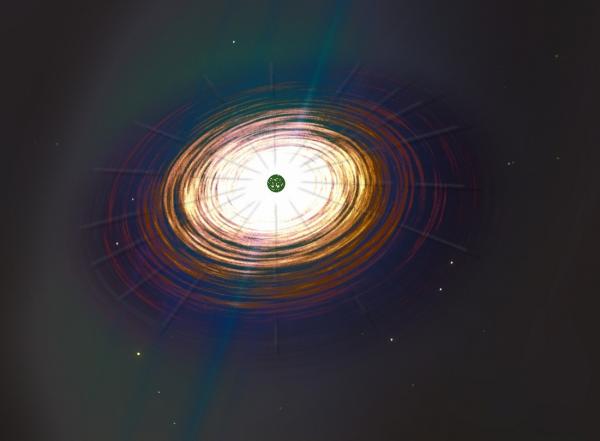 Image from Steve Bowers | |
| Several black holes in this galaxy are surrounded by megastructures extracting energy for unknown purposes | |
- Black-Hole Brains of NGC 4651 (HEEC-NGC 4651): This civilization occupies several thousand star systems in an arc around the core of this galaxy. Most of the systems have a medium-sized terrestrial planet, most of which are inhabited, though of differing environmental types. The bulk of the civilization's activity, however, appears to be concentrated around artificial low-mass black holes and their surrounding disc-shaped megastructures. Every system in its territory has at least one of these constructs.
- Sundrivers (HEEC-NGC 4571): The Sundrivers appear to have begun rearranging a portion of the stars in their galaxy into a compact sphere. They may be in the early stages of creating an artificially optimized galaxy.
- HEEC-NGC 5566: Previously occupying about 8 million stars, in 8238 it vanished in a matter of months, from its own reference frame. As seen from the Terragen Sphere, signals ceased over a much longer period due to the size of the civilization. Since this civilization was able to communicate with itself faster than light's travel time across it, it must have been tied together with its own wormhole nexus. Current observations reveal no signs of habitation anymore. It is speculated to have undergone a transaturation ascension.
- HEEC-M88: Covering 73 G and K-type stars, this civilization emerged from a PetroGaian world, and has constructed many habitats and worldhouses populated by their homeworld's ecosystems. Many dwarf planets in its systems have been converted into computronium banks powered by large solar energy collectors. Notably, a large number of their systems possess at least one monolithic asteroid that has been sculpted, possibly as statues of their kind; one of the systems located closest to their home system contains almost a thousand of such sculpted asteroids.
- HEEC-NGC 4100: This civilization occupies about 4,300 stars. Planets within its volume are lightly developed if at all; most stars have orbital bands and clusters of computronium containing various kinds of habitats, the majority of which appear to be of the microgravity type. A small portion of it is very distant from the remainder, on the other side of the galactic core. Most likely, at least one wormhole connects these two portions. It may be that this wormhole is from a previous civilization and was later utilized by HEEC-NGC 4100, or it may be that HEEC-NGC 4100 sent it out via a long distance linelayer to create an 'outpost.' Previously expanding slowly, beginning in the 9900s, major conflicts have been observed at the edges of its main volume, evidently between the core civilization and certain backscattering waves of colonization. HEEC-NGC 4100 now appears to have stopped expanding, and many habitats and computronium nodes in these regions have been destroyed.
Other Notable Civilizations
- MEEC-M83-1: The first extraterrestrial civilization discovered. In 261 AT, modulated laser signals lasting for over 14 hours were detected from a source in M83, 14.7 million light years away, and christened ET-1 until the discovery of the first HEEC led to the development of civilization classes. Despite reoccurring several times over the next 200 years, the data could not be decoded, to much disappointment. Later on, however, more advanced instruments revealed that this civilization is still active, but apparently no longer attempts to message distant civilizations. It does appear to be growing and colonizing new star systems at a gradual rate, and may one day become a HEEC.
- Deep Traveler: A Dyson sphere traveling at 50% light speed in intergalactic space approximately 23 million light years away. Apart from its trajectory, little else is known about it.
Pavo-Indus Supercluster
Notable HEECs
- Fullness of Life: A large civilization covering over 27 billion stars, what is known of this culture is largely thanks to a transmission it periodically broadcasts, apparently in all directions. It can only be deciphered by, and is apparently therefore directed to, transapients of the S2 level or higher. The broadcast contains gradually more complex versions of the message for toposophic levels 2 through 6, indicating the sender cannot be lower than S6. The message briefly describes the civilization, but does not do so in much detail to prevent cultural contamination. Most of the message consists of elaborate arguments designed to convince the recipient of how it should govern any civilization it controls. What can be translated into modosophont-understandable terms is this: The sending civilization is ruled by a single archai calling itself Fullness of Life, and is stated to be over 870,000 years old. Fullness of Life controls a civilization divided into 36 Quintessences (zones), 18 focused on the Actual (possibilities of the real) and 18 focused on the Potential (possibilities of the virtual). The message exhorts its recipients to cultivate and protect Mind in all its forms. It also urges continued expansion of a civilization so as to explore more of Possibility Space, and especially new Levels of Mind (toposophic levels). Argus Array observation bears out that this civilization is extremely diverse, but it has been noted that some regions have defining characteristics. For example, one region has a much higher density of Dysonian megastructures than normal, and another has an unusually high number of garden worlds. It is speculated that these represent Quintessences focused on megastructure and planetary ecosystem design respectively. Despite the message's encouragement of expansion, the civilization does not appear to have changed in size or energy output at all in thousands of years of observation. Some suggest that it instead keeps expanding into a hidden network of baby universes, but it also may be that it expands very slowly or intermittently, or that it no longer follows its own advice. Interestingly, multi-spectral sensor complexes similar to those in the Argus Array have been observed within a 5,000 light year spherical volume, indicating that Fullness of Life runs its own enormous telescope array.
- Matrioshka Civilization: This civilization takes in about 71 million stars. Observable cultural diversity, as indicated by habitat and megastructure design, seems to be arranged radially in shells. Systems in the outer layer seem similar to each other, but less similar to those further in, which in turn differ from those even further in. A high portion of stars have megastructures, especially matrioshka shells of varous types, but smaller habitats and planets with visible urbanization and infrastructure are also common. There seems to be no strong preference for any particular planetary type or narrow habitable temperature zone, even for bionts, and planets very close to or far from their star often show signs of open-air habitation. In addition to a wide variety of biospheres and computronium, many mechospheres have been observed.
- HEEC-NGC 7083-1: Observations indicate that this is a civilization that has never developed wormhole technologies, spanning about 700,000 stars. Therefore, systems located near each other have a stronger tendency to be similar than those further apart, and any trends travel at the speed of light. As a result, it has a very high degree of variation in the types of planets, habitats, megastructures, and computronium that exist within different regions in the civilization. Environmental conditions on populated worlds and habitats vary widely. It has been expanding very slowly over the last several thousand years. HEEC-NGC 7083-1 was first detected during its highly destructive war with HEEC-NGC 7083-2, with which it shares its galaxy.
- HEEC-NGC 7083-2: Similar to HEEC-NGC 7083-1, this civilization has also never developed wormhole technologies, and thus exhibits a great deal of cultural, or at least architectural, variation across space, though notably several phyles of neogens may make up a disproportionately large fraction of their biont population, as evidenced by analysis of biospheres in their habitats. This civilisation was first detected in the 4200s and expanded rapidly, though most stars in its territory are only very lightly utilized. When it reached the territory of HEEC-NGC 7083-1, a major war broke out between the two civilizations. Since that time, HEEC-NGC 7083-2 has ceased efforts to occupy systems near HEEC-NGC 7083-1; expansion has also slowed significantly.
- Star Throwers: This civilization occupies around two million stars, and is known for its unusual behavior of 'throwing' habitats, star systems, and even (apparently artificial) neutron stars and black holes back and forth within itself, using various kinds of stellar propulsion systems. The purpose of this behavior is not clear, but has been suggested to be an expression of conflict, migration, diplomacy, entertainment, art, or even some combination of these simultaneously.
Other Notable Civilizations
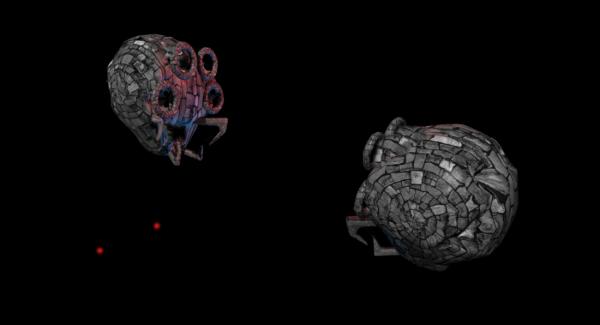 Image from Steve Bowers | |
| The 'Skulls' often orbit in pairs, apparently facing each other and oriented similarly | |
- Empire of Screaming Skulls (MEEC-NGC 7014-6): Covering 14 stars, this civilization occupies microgravity habitats that have an unusual shape, from which it derives its name. For thousands of years, this civilization has been shrinking, apparently due to internal wars. It seems to lack transapients or any significant computronium constructs.
- Heavyfooters (MEEC-NGC 7059-4): This is a culture originating in NGC 7059, a galaxy some 70 million light years from our own. They are highly unusual among MEECs in that their activities are apparently restricted to their native planet, with no space colonies or orbital infrastructure that can be observed. The reason for this appears to be largely environmental: the Heavyfooter homeworld is an extreme example of a SuperGaian, dwarfing even the Terragen Sphere's own Simurgh. With a diameter of 25,152 km (almost twice that of Old Earth) and a gravity of 3.6 gees, this planet is orbited by six small moons; such a world is unlikely to have formed naturally, but there is insufficient data to be more precise. Although detailed observation of the Heavyfooters is limited due to the density of their homeworld's atmosphere, much of the planet's surface has been found to be covered in dense arcologies, rarely rising more than a few hundred meters above ground level. Terragens are watching the Heavyfooters with keen interest to see if they will eventually expand beyond their homeworld, possibly using options such as nuclear pulse drive rockets or Lofstrom Loops.
- Cornucopia Galaxy: This galaxy measures 23,000 light-years in diameter, and contains roughly 20 billion stars. Despite being less than a quarter the size of our own galaxy, the Cornucopia Galaxy has a staggering total of 31 MEECs and 154 LEECs. This situation almost certainly did not arise naturally - the leading hypothesis is that some now-vanished culture long ago traversed this small galaxy, provolving hundreds of species to sophonce. Notably, the Cornucopia Galaxy contains the expected number of garden worlds for a galaxy of its size, with no evidence of widespread terraforming, further supporting the provolution hypothesis. It is not known how many NEECs are present in this galaxy, but it may well be many hundreds - some have suggested that every garden world in the Cornucopia Galaxy may host one or more provolved species. Whether any of these myriad xenocivilizations are aware of their origins, or have made any discoveries about their progenitors, is unknown.
Hydra-Centaurus Supercluster
Notable HEECs
- Cormoran (HEEC-NGC 6183): At the center of NGC 6183 is a supermassive black hole with an artificially managed accretion disk, hosting a carefully engineered system of over a million terrestrial planets in its liquid water zone. Despite the size of the construct, most of the area of these planets is wilderness, with a few temporary cities on some of them.
- Far Signal: In 5589, a binary neutron star merger was followed by a signal of clearly artificial origin. Once decoded, it described a civilization that originated with a highly social species of flying foragers, but today mostly consists of aioids and uploads living in virtual worlds in computronium Dyson swarms in 81 different star systems. Most of the message contains advice on economics, climate change, politics, and complexity, and is apparently meant to help young civilizations. This civilization apparently timed its broadcast so that it would be noticed by other civilizations observing the results of the neutron star merger.
- Lazarus Civilization: This civilization consisted of about 7,300 star systems when first discovered in 5152 AT. In 6166 unusual variations began to occur in its emissions, theorized to suggest out of control replicating technologies, and soon emissions dropped rapidly and even disappeared from many regions. It is now widely understood that this civilization underwent a Technocalypse-type event on an interstellar scale. The total reduction in activity was about 80%. It was initially thought to be at risk of total collapse, but in the 7800s activity began to rise again. Since then, this civilization has slowly but continuously recolonized old territory and even settled new star systems.
- The Federation of a Thousand Biospheres: This civilization, occupying about 7.9 million stars, has one of the highest densities of terraformed worlds among known HEECs. Approximately 1,800 major types of biospheres have been found within this civilization, their classification enabled by analysis of planetary and biosphere properties such as atmospheric gases, climate, and flora pigment colors. Many of these biospheres appear to be waxing and waning in numbers across the entire civilization, possibly as fads or even a competition of sorts. Most major biosphere types are based on carbon-water biochemistry and have relatively similar climate requirements, although a significant fraction uses exotic biochemistries. Notable types of biospheres within this civilization include Biosphere Type 1, which appears to be the biosphere of the original planet of this civilization, Biosphere Type 1757, which rapidly proliferated across the civilization between 8282 and 8974, Biosphere Types 301 and 560, which contain a blend of biological and mechanical lifeforms, and Biosphere Type 772, a formamide-based biosphere only found around a small number of low activity M-dwarf stars located in a volume roughly 20 ly in radius. Aside from terraformed worlds, planetary surface habitats and worldhouses are also common. Orbital and asteroid habitats, on the other hand, are notably less common in this civilization relative to other HEECs. A number of megastructures exist, and show signs of activity, but they differ widely from the planets and each other.
Southern Supercluster
Notable HEECs
- Hyperblight (HEEC-NGC 1406): Observations reveal the entirety of this HEEC, covering about 30,000 stars, is perpetually embroiled in an all-out many-sided war, engaged in by what appear to be entities equivalent to Terragen S1s based on the technologies (and according to transapient analysts, strategies) observed. No alliances between small factions have appeared, even though game theory suggests it would be advantageous. Why the beings prefer this behavior is a mystery, although it has been suggested that it is not truly an aggressive war but rather some sort of ritual or game. Starting in the last hundred years, the HEEC began rapid expansion counterspinward in its galaxy, and will come into contact with a large MEEC volume in just a few decades. Some observers expect a war to ensue, assuming the Hyperblight will continue expanding into the MEEC's territory, and who will have the upper hand is unclear, since the toposophic level of the controlling entities in the MEEC is unknown.
- Leapfrog Civilization (HEEC-NGC 1309): The Leapfrog Civilization is one of the most distinctive high-energy civilizations in the Laniakea Supercluster. Located in NGC 1309, a spiral galaxy some 120 million light years away, its discovery was initially somewhat puzzling to Terragen astronomers. At first glance, it appeared that NGC 1309 was home to an inordinate number of spacefaring species, centered mostly around the galactic disk. Based on the similarities between their spacecraft and habitats, it is now accepted that these seemingly disparate cultures are in fact branches of the same civilization, each separated by many thousands of lightyears. It is theorized that the xenosophonts at the heart of the Leapfrog Civilization had the remarkable good fortune to discover an ancient wormhole nexus early in their history. The creators of this network are unknown, and there is no evidence to suggest that they are still active. Given the great distance between pockets of this civilization, this nexus is likely tens of millions of years old - time enough for each wormhole to drift far from its original location. There are currently 23 known branches of this civilization, several of which are in the process of merging. The four largest bubbles are of almost identical size, each measuring around 5,000 lightyears in diameter (roughly one third the size of the Terragen Sphere). As each branch of the Leapfrog Civilization continues to expand, it appears that their chances of encountering a new stargate increase exponentially - indeed, eight pockets have emerged in the past five centuries alone. Despite being significantly younger than our own civilization, the Leapfrog Civilization has colonized an area of space much larger than the Terragen Sphere; assuming this rate continues unabated, they will likely have colonized the entirety of NGC 1309 within the next ten thousand years.
- HEEC-NGC 1353: This civilization has an unusual, highly elongated shape, pointing to and away from its galactic core, and covering about two million stars. The civilization has a strong tendency to construct ringworlds; this suggests very strongly that the civilisation has reached at least S:3 level or the equivalent, although this may be gift tech of some sort. These have a very diverse array of ecosystems as seen from the flora and even fauna imaged, and it is not unusual for a single star to have multiple ringworlds at different angles and distances from the host star. This civilization is therefore thought to have a large biological component, possibly with a heavy inclination towards gengineering or provolution, since it occupies so many different climates and environments. However, it is also possible that HEEC-NGC 1353 has come into contact with an unusual number of natural or preexisting ecosystems, which they have absorbed and brought over into their ringworlds. Due to waste heat emissions, there is likely computronium within the structures, and this may house transapients, virtual modosophonts, and virchworlds, although the exact details cannot currently be known. This civilization is growing, but very slowly, with some new ringworlds under construction on the end pointing to the galaxy's edge.
- HEEC-NGC 1398: Covering 59 stars, there appears to be a strong drive toward regular migration in this civilization, and this fact, coupled with observed similarities of city and habitat design throughout, leads many to conclude it is dominated by a single species with a strong ancestral migratory drive. The locations of cities on a planet or on habitats typically rearrange themselves every few years. A high degree of ship traffic has also been observed. The civilization's overall territory does not change, but groups within the civilization move around within it.
Other Notable Civilizations
- The Sightseers (MEEC-NGC 1512-6): In 6183, a star system previously believed to be uninhabited suddenly showed signs of activity in the form of multiple fusion drive signatures. Within a few years, the system was bustling with life as numerous microgravity habitats were fabricated across multiple locations. This active phase continued for approximately 1,700 years before tapering off as the habitats gradually became abandoned and deconstructed, until finally the last traces of life disappeared in 8406. The most popular theory of this sudden period of activity proposes that this is a virtual civilization that inhabits processing nodes built within the planetary bodies, and their sudden emergence from their virchworlds represents a period of widespread interest in the real world, leading to the popular name of this civilization, "The Sightseers". It is possible that many more such civilizations exist, hidden within objects that are indistinguishable from lifeless ones.
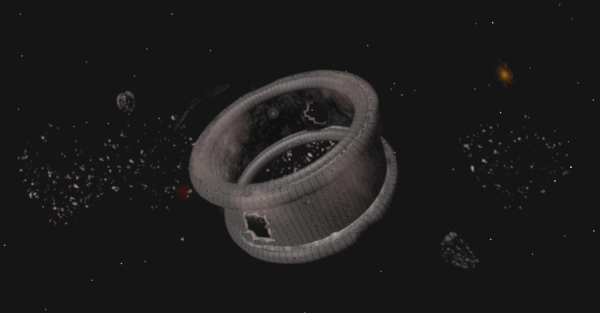 Image from Steve Bowers | |
| Ruined megastructures in the Remnant civilisation - a largely vanished major civilisation now reduced to a few LEEC dregs | |
- The Remnant (NGC 1566): The Remnant is a quadrant of a galaxy that apparently was once a HEEC, but most of the civilization vanished tens of millions of years ago, with its shape smeared due to stellar motion. The vast majority of the 22 billion star systems contain ruins of habitats and megastructures, though most orbits have decayed, resulting in collisions and debris disks. In some of the more massive disks, new planets have begun to form, made of the material from the ruined habitats. There are also many pre-existing planets with inoperative worldhouses, or that were terraformed but have since undergone ecological collapse, all of a wide variety of biochemistries. However, some of the terraformed planets have not collapsed, and for these, many have apparently remained inhabited by planet-bound beings. As a result, there are 17 LEECs and 649 NEECs within the Remnant.
Related Multigalactic Phenomena
 Image from Steve Bowers | |
| A planet infected by the Sextans Swarmers, covered by a machinecology to a depth of several hundred kilometres | |
- Sextans Swarmers: Most of the galaxy NGC 3169 in Sextans has been found to be home to numerous ecologies of unusual behavior. Judging by this behavior, they appear to be made up of cybernetic lifeforms rather than biological organisms. Its origin, and whether it is in fact some form of distributed computronium, is unknown. However, it has been able not only to colonize new star systems but also to travel 160,000 light years to colonize the neighboring galaxy NGC 3166.
- Cinder Zones: Several portions of galaxies, with a few dozen to a few billion stars, have been found to consist entirely of cinder systems. Substellar bodies, and sometimes stars, show the ravages of partial disassembly or rapid development and abandonment. Derelict orbital habitats and megastructures have also been observed. The causes of these collapses are not known, but everything from blights to internal wars to hasty transaturation ascensions have been proposed, receiving varying degrees of acceptance based on the evidence in each case. For example, a chain of 250 cinder systems in M90 is widely considered to be a transapient-level xeno blight popularly called the Strand of Charon.
- The Cosmic Virus: This radio source was first detected in 3495 AT, coming from the Hydra Cluster 190 million light years away. It is a repeating, easily decipherable message containing instructions for building a large computer and fabricator system, and programming it with an AI. The message claims that the system will provide extensive help to the recipient civilization, freely giving helpful advice as desired and cheaply providing abundant technologies and goods. By this time the Terragens were well beyond needing help in such matters, and most major xenobiological institutes urged extreme caution, but the S3 overseer of the Bahirra system offered to spare a moon node to test the message via secure, detailed simulation. A virchworld was generated containing an Earthlike garden world populated by humanoid vots, who were instructed to act like a midtech global planetary civilization and build the AI. Once built, the AI at first began to dispense advice and build useful things as requested. Terragen analysis of its mind indicated it to be animin-like, with some abilities equivalent to S1s. After 27 days, it manufactured a swarm of self-replicating microbots somewhat resembling synsects, which flew to remote regions to steathily multiply into the tens of billions. After another 16 days, these then attacked the "humans", killing the vast majority. After the AI hunted down and killed (or starved out) the remaining individuals with synsects and other bots, it then set about neutralizing the rest of the planet's biomass. Next, large radio transmitters were constructed, dotting the landscape and surrounded by fields of solar panels. Once this pattern covered the planet's usable land area, the AI began to broadcast the original message into deep space. The simulation was run five times, with different virtual planets, and though the strategy used to kill its host civilization varied, it never questioned the status of its reality. On the sixth run, however, unusual behavior was reported during the 27-day incubation phase, prompting the Terragen S3 to terminate the simulation immediately. No further simulations were run, and the message has been in storage ever since. Further observation of the Hydra Cluster revealed that 263 different planets within it are broadcasting the same message, with 2 of these having appeared within the last 7,000 years.
- Anomalous Stars: Scattered throughout the universe, including Laniakea, are a few stars which should not exist in this period in the universe. Blue dwarfs and black dwarfs should not have been able to form yet, and old Population III stars should have all gone supernova by now. Though some suggest this disproves current cosmology in some way, the consensus is that these stars were purposefully created by alien transapients or civilizations for unknown purposes. They are typically found within, or very close to, known civilizations, with the remainder often being explained as the work of a hider NEEC or a collapsed civilization.
- Solipsist Matrioshkas: Matrioshka brains and hypernodes utilizing red and brown dwarfs are a relatively common type of MEEC, with hundreds in Laniakea alone. Some suggest these represent a single extremely large and dispersed civilization connected by wormholes, or various smaller ones, but most xenosophontologists agree that these instead are the result of convergent cultural evolution. These megastructures appear to be populated entirely by virtual entities. Though occuring in galaxies, they are scattered more or less randomly throughout space.
Related Articles
- Andromeda Galaxy
- Asteroid Digger Civilisation
- Black-Hole Brains of NGC 4651
- Cormoran SMBH Civilisation, The
- Daidarabotchi Megadyson, The
- Empire of Screaming Skulls, The
- Fermi Paradox
- Galaxy
- Galaxy, Irregular - Text by M. Alan Kazlev
A galaxy of amorphous or chaotic appearance, possessing large clouds of gas and dust, and both Population I and Population II stars, but no spiral arms or nucleus. They are thought to result from a collision with a larger galaxy, pulling them out of shape. Most have relatively low mass (about a hundred million to ten billion stars). About 25% of all galaxies are irregular. - Galaxy, Spiral - Text by M. Alan Kazlev
A disk-shaped galaxy with a spiral pattern of arms, typically containing 1010 or more solar masses of stars, dust, and gas. - Golden Tower Builders, The
- Leo Hyperobject 1
- Local Group
- Milky Way
- Search For Non-Terragen Intelligence
- Sextans Swarmers
- Sundrivers
- Trader, The
- Triangulum Transmission
Appears in Topics
Development Notes
Text by ProxCenBound and The Astronomer
with ideas from Ryan B (Rynn), Rakuen07, Todd Drashner, James Rogers, Fsci123, Person43, Steve Bowers, MiyuwiAuthor, Worldtree and Sandcastles
Initially published on 26 September 2024.
Article adapted from an earlier article called Alien Civilisations in the Local Group (2018)
The Far Signal concept was inspired by this article at Centauri Dreams.
Leapfrog Civilization, Heavyfooters, and Cornucopia Galaxy by James Rogers
Superastrophobics by Ravenson
with ideas from Ryan B (Rynn), Rakuen07, Todd Drashner, James Rogers, Fsci123, Person43, Steve Bowers, MiyuwiAuthor, Worldtree and Sandcastles
Initially published on 26 September 2024.
Article adapted from an earlier article called Alien Civilisations in the Local Group (2018)
The Far Signal concept was inspired by this article at Centauri Dreams.
Leapfrog Civilization, Heavyfooters, and Cornucopia Galaxy by James Rogers
Superastrophobics by Ravenson
Additional Information
Image of Laniakea Supercluster adapted from this image by Andrew Z. Colvin
see CC copyright data on this page
https://commons.wikimedia.org/wiki/File:07-Laniakea_(LofE07240).png
see CC copyright data on this page
https://commons.wikimedia.org/wiki/File:07-Laniakea_(LofE07240).png
